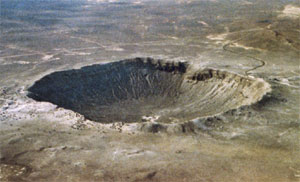 Apophis is about the same size as the asteroid that blasted
Apophis is about the same size as the asteroid that blasted
the mile-wide Barringer Crater in Arizona.
Credit: David Roddy, USGSFriday the 13th, April, 2029: If you're superstitious, this might not be a good day to schedule a near-Earth asteroid encounter. But, as it happens, that's the day that the Near Earth Asteroid (NEA) Apophis will make a very close flyby of Earth--a once in 800 years event for an asteroid Apophis' size.
Fortunately, scientists have already predicted, 20 years in advance, that this is our lucky day: Apophis won't hit the Earth at that time. Rest assured (pretty much).
Discovered in 2004, Apophis is an asteroid about 270 meters across that orbits the Sun at distances ranging from about one astronomical unit (1 AU; the distance between Earth and the Sun) and about three quarters of an AU. Apophis orbits the Sun once every 323 days.
After its initial discovery, before our knowledge of its orbital trajectory had been refined, astronomers had predicted that there was a small chance it could hit the Earth on April 13, 2029, but as we got a clearer picture of its orbit the probability dwindled to practically nothing. Instead, Apophis will pass by Earth no closer than about 18,000 miles. Whew! Disaster averted, and we didn't even have to send Bruce Willis to deal with it.
But wait--that's not all. Though Apophis almost certainly won't hit us in 2029, there's a chance that this close encounter will set the asteroid up for an impact with Earth in 2036--something like 1 in 45,000.
